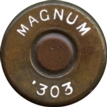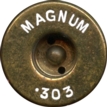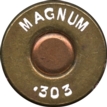





The following is an article by John Pople-Crump in the June 1997 issue of the ECRA newsletter
385-25/ From lohn Pople-Crump (G.B.) June 1997
A brief history of the, .303 Magnum cartridge: 1919-1932:
In 1919, the National Rifle Association of Great Britain resumed its annual shooting matches at Bisley. There had been no N.R.A. matches during the 1914-1918 War. Most competitions continued as last shot in 1914, except for the Match Rifle events. Before World War One, any caliber of rifle up to .315 inch was permissible. From 1919, this rule was to change. A prime purpose of the N.R.A.’s Match Rifle competitions was to develop accuracy at long ranges, between 900-1200 yards. The N.R.A. was sponsored by the War Office, who expected feed-back from any developments that might have military potential. It was customary for the War Office to send an Officer to Bisley each year as an observer.
An important rule of Match Rifle competition was that “the cartridge should be serviceable from a military point of view”. In the decade prior to World War One, this rule had been relaxed in the quest for the ultimate Match Rifle cartridge. The result had been cartridges like the .280 Ross and the .276 Eley Match Rifle , which were quite unsuitable for military use. A Match Rifle Committee, formed by the N.R.A. in 1919, decided that future Match Rifle ammunition would be restricted to two types, the current .303 Mark VII Service cartridge, and a new cartridge, called the .303 Magnum. The term ‘Magnum’ was used then, as it is now, to describe a cartridge case holding a greater amount of propellant than normal for a given length and shape, i.e. a fat case for the caliber.
Kynoch Ltd. developed the .303 Magnum, which was a necked-up version of a .276 inch cartridge that was on the verge of Government adoption when World War One began, The .276 case was a rebated rimless design, but this was changed to a rimless, or a semi-rimless design on the .303 Magnum cases. Rimless .303 Magnum cases had disappeared by 1922, but a semi-rimless case remained standard until its manufacture ceased in 1932. By contrast, bullet designs progressed radically and became the main focus of the Match Rifle Committee’s efforts. Few records remain of the .303 Magnum project, and I have been unable to verify the bullets used at Bisley in 1919 and 1920. In 1921, the bullet loaded into the .303 Magnum for the Bisley meeting, was called the ‘Bisley’ bullet and weighed 175 grains. The ‘Bisley’ bullet was flat-based, with an envelope of mild steel, coated with cupro-nickel. Its velocity was 2.793 f/sec at 30 yards from the muzzle and the remaining velocity at 1.000 yards was 1.184 f/sec.
At the 1922 Bisley meeting, the .303 Magnum was loaded with a ‘Stream-Line‘ bullet having a tapered base. The bullet weight was 175 grains and it also had a cupro-nickel coated mild steel envelope. The tapered base improved air flow around the bullet, giving it a flatter trajectory and a longer range than the ‘Bisley’ bullet, or the .303 inch Mark VII service bullet. Its velocity was 2.801 f/sec at 30 yards from the muzzle and 1.370 f/sec at 1.000 yards. The fouling of rifle barrels with metal particles from bullet envelopes was a never ending problem for Match rifle shooters. The Match Rifle Committee had stipulated a cupro-nickel plated mild steel envelope in the hope of reducing the barrel fouling. Early .303 Magnum were lubricated, which reduced fouling, but this was not a desirable practice. If grease from a bullet found its way onto the chamber walls, the case lost its friction grip upon firing and all the pressure headed backwards towards the bolt. If the case head was weak and separated, all the pressure was released against the bolt lugs, sometimes with catastrophic results for both rifle and shooter.
The Match Rifle Committee asked Kynoch to investigate alternative metals for bullet envelopes. In 1923, Kynoch introduced a new bullet, with an envelope made of ‘Nobeloy’. The word ‘Nobeloy’ was registered as a Trade Mark and was the property of Kynoch Ltd, who were now part of Nobel Industries. ‘Nobeloy’ was an alloy of 90% copper, 8% zinc and 2% tin, and was manufactured under licence from the Western Cartridge Company in the U.S.A., who called their version ‘Lubaloy.
The 1923 ‘Stream-Line‘ bullets with their ‘Nobeloy’ envelopes were loaded into the .303 Magnum cartridges used at Bisley that year. The ‘Nobeloy’ envelopes eliminated the barrel fouling problems. From 1924 onwards, the only major revision to the ‘Stream-Line’ bullet was to add a definite edge or skirt at the junction of the taper and the bullet body, which improved accuracy. After the 1932 Bisley meeting, the Match Rifle Committee decided that nothing further could be done to improve the .303 Magnum cartridge and bullet. From 1933, the Magnum bullet was loaded into ordinary .303 inch service cases and became the only permitted ammunition for Match Rifle events until 1963. From 1964 the 7,62x51mm became the only cartridge permitted in N.R.A. Match Rifle events.
In 1938, the .303 Magnum bullet was given a cannelure, for crimping the case mouth onto it and was adopted as the Mark Vlllz service cartridge, for use in Vickers medium machine-guns. The long—range accuracy pf the Mark Vlllz bullet made it ideal for indirect covering fire. Throughout the 1930’s, Kynoch applied the ‘Stream-Line‘ principle to other bullets, including the .5 inch Vickers and 13,2mm Hotchkiss calibers.
The development of the .303 Magnum cartridge was a unique and very successful event. The programme co-ordinated by the Match Rifle Committee, brought positive benefits for ammunition manufacturers, shooters, and the military authorities.
